Undirected C-H Bond Activation in Aluminium Hydrido Enaminonates
Abstract
1. Introduction
2. Results and Discussion
2.1. Synthesis of Ligand and Aluminium Compounds
2.1.1. Structural Characterization of Compounds 3 and 4a
2.1.2. Thermal Behavior of Compounds 3 and 4a
2.2. Thin Film Deposition
3. Materials and Methods
3.1. Synthesis of Ligand and Complexes
3.1.1. Synthesis of 1
3.1.2. Synthesis of 2
3.1.3. Synthesis of 3, 4, 4a, 4b and 4b′
4. Conclusions
Supplementary Materials
Author Contributions
Funding
Institutional Review Board Statement
Informed Consent Statement
Data Availability Statement
Acknowledgments
Conflicts of Interest
Sample Availability
References
- Veith, M.; Faber, S.; Wolfanger, H.; Huch, V. (tert-Butoxy) Aluminium and Gallium Hydrides. Chem. Ber. 1996, 4, 129–381. [Google Scholar] [CrossRef]
- Marchand, P.; Carmalt, C.J. Molecular Precursor Approach to Metal Oxide and Pnictide Thin Films. Coord. Chem. Rev. 2013, 257, 3202–3221. [Google Scholar] [CrossRef]
- Meléndez, J.; North, M.; Pasquale, R. Synthesis of Cyclic Carbonates from Atmospheric Pressure Carbon Dioxide Using Exceptionally Active Aluminium (salen) Complexes As Catalysts. Eur. J. Inorg. Chem. 2007, 21, 3323–3326. [Google Scholar] [CrossRef]
- Darensbourg, D.J.; Billodeaux, D.R. Aluminum Salen Complexes and Tetrabutylammonium Salts: A Binary Catalytic System for Production of Polycarbonates from CO2 and Cyclohexene Oxide. Inorg. Chem. 2005, 44, 1433–1442. [Google Scholar] [CrossRef] [PubMed]
- Schlafer, J.; Graf, D.; Fornalczyk, G.; Mettenborger, A.; Mathur, S. Fluorinated Cerium (IV) Enaminolates: Alternative Precursors for Chemical Vapor Deposition of CeO2 Thin Films. Inorg. Chem. 2016, 55, 5422–5429. [Google Scholar] [CrossRef]
- Li, W.; Ma, X.; Walawalkar, M.G.; Yang, Z.; Roesky, H.W. Soluble Aluminum Hydrides Function as Catalysts in Deprotonation, Insertion, and Activation Reactions. Coord. Chem. Rev. 2017, 350, 14–29. [Google Scholar] [CrossRef]
- Klinkhammer, K.W.; Uhl, W.; Wagner, J.; Hiller, W. K2 [Al12iBu12], a Compound with Al12 Icosahedra. Angew. Chem. Int. Ed. 1991, 30, 179–180. [Google Scholar] [CrossRef]
- Gevorgyan, V.; Lukevics, E. Phase-transfer Catalysis in Reduction by Lithium Aluminium Hydride. J. Chem. Soc. Chem. Commun. 1985, 18, 1234–1235. [Google Scholar] [CrossRef]
- Franz, D.; Irran, E.; Inoue, S. Synthesis, Characterization and Reactivity of an Imidazolin-2-iminato Aluminium Dihydride. Dalton Trans. 2014, 43, 4451–4461. [Google Scholar] [CrossRef]
- Veith, M.; Frères, J.; Huch, V.; Zimmer, M. Synthesis and Characterization of Novel Siloxyalanes. Organometallics 2006, 25, 1875–1880. [Google Scholar] [CrossRef]
- Jakobsson, K.; Chu, T.; Nikonov, G.I. Hydrosilylation of Olefins Catalyzed by Well-Defined Cationic Aluminum Complexes: Lewis Acid Versus Insertion Mechanisms. ACS Catal. 2016, 6, 7350–7356. [Google Scholar] [CrossRef]
- Bach, P.; Albright, A.; Laali, K.K. Influence of Lewis Acid and Solvent in the Hydrosilylation of Aldehydes and Ketones with Et3SiH; tris (pentafluorophenyl) Borane B (C6F5)3 versus metal triflates [M(OTf)3; M = Sc, Bi, Ga, and Al]–mechanistic implications. Eur. J. Org. Chem. 2009, 12, 1961–1966. [Google Scholar] [CrossRef]
- Blackwell, J.M.; Sonmor, E.R.; Scoccitti, T.; Piers, W.E. B (C6F5)3-catalyzed Hydrosilation of Imines via Silyliminium Intermediates. Org. Lett. 2000, 2, 3921–3923. [Google Scholar] [CrossRef]
- Roesler, R.; Har, B.J.; Piers, W.E. Synthesis and Characterization of (perfluoroaryl) Borane-functionalized Carbosilane Dendrimers and their Use as Lewis Acid Catalysts for the Hydrosilation of Acetophenone. Organometallics 2002, 21, 4300–4302. [Google Scholar] [CrossRef]
- Houghton, A.Y.; Hurmalainen, J.; Mansikkamäki, A.; Piers, W.E.; Tuononen, H.M. Direct Observation of a Borane–Silane Complex Involved in Frustrated Lewis-pair-mediated Hydrosilylations. Nat. Chem. 2014, 6, 983–988. [Google Scholar] [CrossRef]
- Hermeke, J.; Mewald, M.; Oestreich, M. Experimental Analysis of the Catalytic Cycle of the Borane-Promoted Imine Reduction with Hydrosilanes: Spectroscopic Detection of Unexpected Intermediates and a Refined Mechanism. J. Am. Chem. Soc. 2013, 135, 17537–17546. [Google Scholar] [CrossRef]
- Tobisu, M.; Chatani, N. A Catalytic Approach for the Functionalization of C (sp3)—H Bonds. Angew. Chem. Int. Ed. 2006, 45, 1683–1684. [Google Scholar] [CrossRef]
- Pan, S.C. Organocatalytic C–H Activation Reactions. Beilstein J. Org. Chem. 2012, 8, 1374–1384. [Google Scholar] [CrossRef]
- Ren, Z.; Mo, F.; Dong, G. Catalytic Functionalization of Unactivated sp3 C–H Bonds via Exo-directing Groups: Synthesis of Chemically Differentiated 1, 2-diols. J. Am. Chem. Soc. 2012, 134, 16991–16994. [Google Scholar] [CrossRef]
- Simmons, E.M.; Hartwig, J.F. Catalytic Functionalization of Unactivated Primary C–H Bonds Directed by an Alcohol. Nature 2012, 483, 70–73. [Google Scholar] [CrossRef]
- Peng, B.; Maulide, N. The Redox-Neutral Approach to C-H Functionalization. Chem. Eur. J. 2013, 19, 13274–13287. [Google Scholar] [CrossRef] [PubMed]
- Fornalczyk, G.; Valldor, M.; Mathur, S. Monomeric Iron Heteroarylalkenolates: Structural Design Concepts and Investigations on Their Application in Chemical Vapor Deposition. Cryst. Growth Des. 2014, 14, 1811–1818. [Google Scholar] [CrossRef]
- Bruückmann, L.; Tyrra, W.; Stucky, S.; Mathur, S. Novel Air-stable and Volatile Bis (pyridylalkenolato) Palladium (II) and Platinum (II) Derivatives. Inorg. Chem. 2012, 51, 536–542. [Google Scholar] [CrossRef] [PubMed]
- Mori, K.; Ehara, K.; Kurihara, K.; Akiyama, T. Selective Activation of Enantiotopic C(sp3)−Hydrogen by Means of Chiral Phosphoric Acid: Asymmetric Synthesis of Tetrahydroquinoline Derivatives. J. Am. Chem. Soc. 2011, 133, 6166. [Google Scholar] [CrossRef]
- Mori, K.; Kawasaki, T.; Sueoka, S.; Akiyama, T. Expeditious Synthesis of Benzopyrans via Lewis Acid-Catalyzed C−H Functionalization: Remarkable Enhancement of Reactivity by an Ortho Substituent. Org. Lett. 2010, 12, 1732. [Google Scholar] [CrossRef] [PubMed]
- Mahoney, S.J.; Moon, D.T.; Hollinger, J.; Fillion, E. Functionalization of Csp3–H bond—Sc(OTf)3-Catalyzed Domino 1, 5-hydride shift/cyclization/Friedel–Crafts Acylation Reaction of Benzylidene Meldrum’s Acids. Tetrahedron Lett. 2009, 50, 4706. [Google Scholar] [CrossRef]
- Veith, M.; Faber, S.; Hempelmann, R.; Janssen, S.; Prewo, J.; Eckerlebe, H. Synthesis and Microstructure of Nanostructured Al/Al2O3 (H)-composite. J. Mater. Sci. 1996, 31, 2009–2017. [Google Scholar] [CrossRef]
- König, R.; Scholz, G.; Thong, N.H.; Kemnitz, E. Local Structural Changes at the Formation of Fluoride Sols and Gels: A Mechanistic Study by Multinuclear NMR Spectroscopy. Chem. Mater. 2007, 19, 2229–2237. [Google Scholar] [CrossRef]
- Florczak, M.; Kowalski, A.; Libiszowski, J.; Majerska, K.; Duda, A. Application of the 27Al NMR spectroscopy to studies of mechanisms of cyclic esters polymerization. Polimery 2007, 52, 722–729. [Google Scholar] [CrossRef]
- Akitt, J.W. Multinuclear studies of aluminium compounds. Prog. Nucl. Magn. Reson. Spectrosc. 1989, 21, 1–149. [Google Scholar] [CrossRef]
- Moravec, Z.; Sluka, R.; Necas, M.; Jancik, V.; Pinkas, J. A Structurally Diverse Series of Aluminum Chloride Alkoxides [ClxAl (μ − OR)y]n (R = nBu, cHex, Ph, 2, 4-tBu2C6H3). Inorg. Chem. 2009, 48, 8106. [Google Scholar] [CrossRef]
- Li, H.; Meziani, M.J.; Kitaygorodskiy, A.; Lu, F.; Bunker, C.E.; Fernando, K.S.; Sun, Y.P. Preparation and Characterization of Alane Complexes for Energy Applications. J. Phys. Chem. 2010, 114, 3318–3322. [Google Scholar] [CrossRef]
- Aldridge, S.; Downs, A.J. Hydrides of the Main-group Metals: New Variations on an Old Theme. Chem. Rev. 2001, 101, 3305–3366. [Google Scholar] [CrossRef] [PubMed]
- Veith, M.; Grobelsek, I.; Kirs, T.; Aktas, C.; Dufloux, C. Oriented Aluminum Nanocrystals in A One-step Process. Thin Solid Film 2014, 564, 128–134. [Google Scholar] [CrossRef]
- Veith, M. Single-Source-Precursor CVD: Alkoxy and Siloxy Aluminum Hydrides. Precursor Chemistry of Advanced Materials; Springer: Berlin/Heidelberg, Germany, 2005; Volume 9, p. 81. [Google Scholar]
- König, R.; Scholz, G.; Veiczi, M.; Jäger, C.; Troyanov, S.I.; Kemnitz, E. New crystalline aluminumalkoxide oxide fluorides: Evidence of the mechanism of the fluorolytic sol–gel reaction. Dalton. Trans. 2011, 40, 8701–8710. [Google Scholar] [CrossRef] [PubMed]
- Uhl, W.; Jana, B. Reactions of β-diketiminatoaluminum Hydrides with Tert-butyl Hydrogenperoxide–Facile Formation of Dialuminoxanes Containing Al–O–Al Groups. J. Organomet. Chem. 2011, 694, 1101–1106. [Google Scholar] [CrossRef]
- Darensbourg, D.J.; Karroonnirun, O.; Wilson, S.J. Ring-opening polymerization of cyclic esters and trimethylene carbonate catalyzed by aluminum half-salen complexes. Inorg. Chem. 2011, 50, 6775. [Google Scholar] [CrossRef]
- González-Gallardo, S.; Jancik, V.; Díaz-Gómez, D.G.; Cortés-Guzmán, F.; Hernández-Balderas, U.; Moya-Cabrera, M. Reactivity patterns for the activation of CO2 and CS2 with alumoxane and aluminum hydrides. Dalton Trans. 2019, 48, 5595–5603. [Google Scholar] [CrossRef]
- León Rayo, D.F.; Mansour, A.; Wu, W.; Bhawal, B.N.; Gagosz, F. Steric, Electronic and Conformational Synergistic Effects in the Gold (I)-catalyzed α-C−H Bond Functionalization of Tertiary Amines. Ang. Chem. Int. Ed. 2023, 62, e202212893. [Google Scholar] [CrossRef]
- Das, A.; Patil, N.T. Enantioselective C−H functionalization reactions under gold catalysis. Chem. Eur. J. 2022, 28, e202104371. [Google Scholar]
- Sandrock, G.; Reilly, J.; Graetz, J.; Zhou, W.M.; Johnson, J.; Wegrzyn, J. Alkali Metal Hydride Doping of α-AlH3 for Enhanced H2 Desorption Kinetics. J Alloys Compd. 2006, 421, 185. [Google Scholar] [CrossRef]
- Ponja, S.D.; Parkin, I.P.; Carmalt, C.J. Synthesis and material characterization of amorphous and crystalline (α-) Al2O3 via aerosol assisted chemical vapour deposition. RSC Adv. 2016, 6, 102956–102960. [Google Scholar] [CrossRef]
- Duan, X.; Tran, N.H.; Roberts, N.K.; Lamb, R.N. Solvothermal Approach for Low Temperature Deposition of Aluminium Oxide Thin Films. Thin Solid Films 2010, 518, 4290–4293. [Google Scholar] [CrossRef]
- Brazeau, A.L.; Barry, S.T. Atomic Layer Deposition of Aluminum Oxide Thin Films from a Heteroleptic, Amidinate-containing Precursor. Chem. Mater. 2008, 20, 7287–7291. [Google Scholar] [CrossRef]
- Mai, L.; Gebhard, M.; De Los Arcos, T.; Giner, I.; Mitschker, F.; Winter, M.; Devi, A. Unearthing[3-(Dimethylamino) propyl] Aluminium (III) Complexes as Novel Atomic Layer Deposition (ALD) Precursors for Al2O3: Synthesis, Characterization and ALD Process Development. Chem. Eur. J. 2017, 23, 10768–10772. [Google Scholar] [CrossRef] [PubMed]
- Carmalt, C.J.; Mileham, J.D.; White, A.J.; Williams, D.J.; Rushworth, S. Synthetic and structural studies on aluminium thiolate complexes. Polyhedron 2003, 22, 2655–2660. [Google Scholar] [CrossRef]
- Altomare, A.G.; Cascarano, G.; Giacovazzo, C.; Guagliardi, A.; Burla, M.C.; Polidori, G.T.; Camalli, M. SIRPOW. 92–a program for automatic solution of crystal structures by direct methods optimized for powder data. J. Appl. Crystallogr. 1994, 27, 435–436. [Google Scholar] [CrossRef]
- Sheldrick, G.M. A Short History of SHELX. Acta Crystallogr. Sect. A Found. Crystallogr. 2008, 64, 112–122. [Google Scholar] [CrossRef] [PubMed]
- Proffen, T.; Neder, R.B. DISCUS, A Program for Diffuse Scattering and Defect Structure Simulations–update. J. Appl. Crystallogr. 1999, 32, 837–838. [Google Scholar] [CrossRef]
- Farrugia, L.J. WinGX and ORTEP for Windows: An update. J. Appl. Crystallogr. 2012, 45, 849–854. [Google Scholar] [CrossRef]


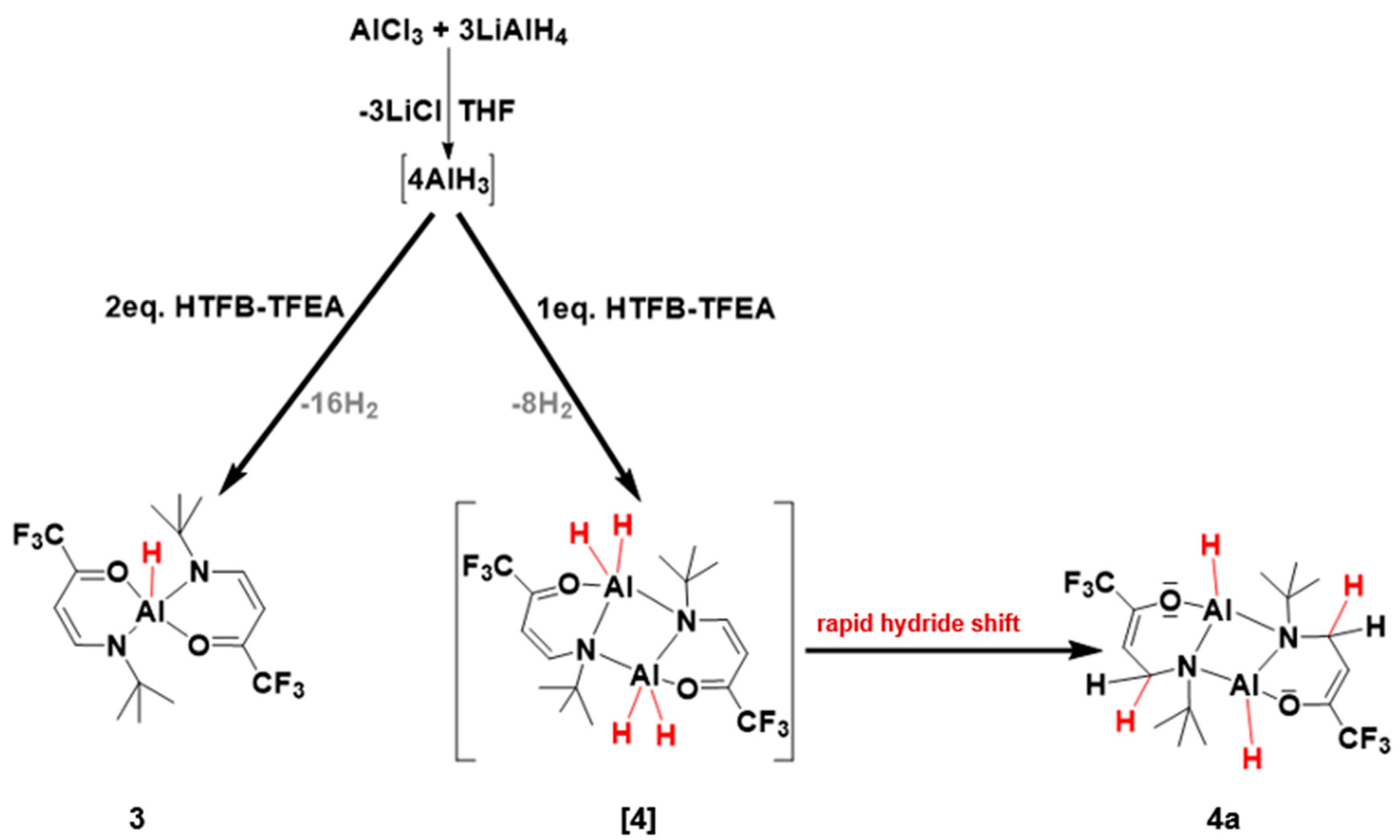


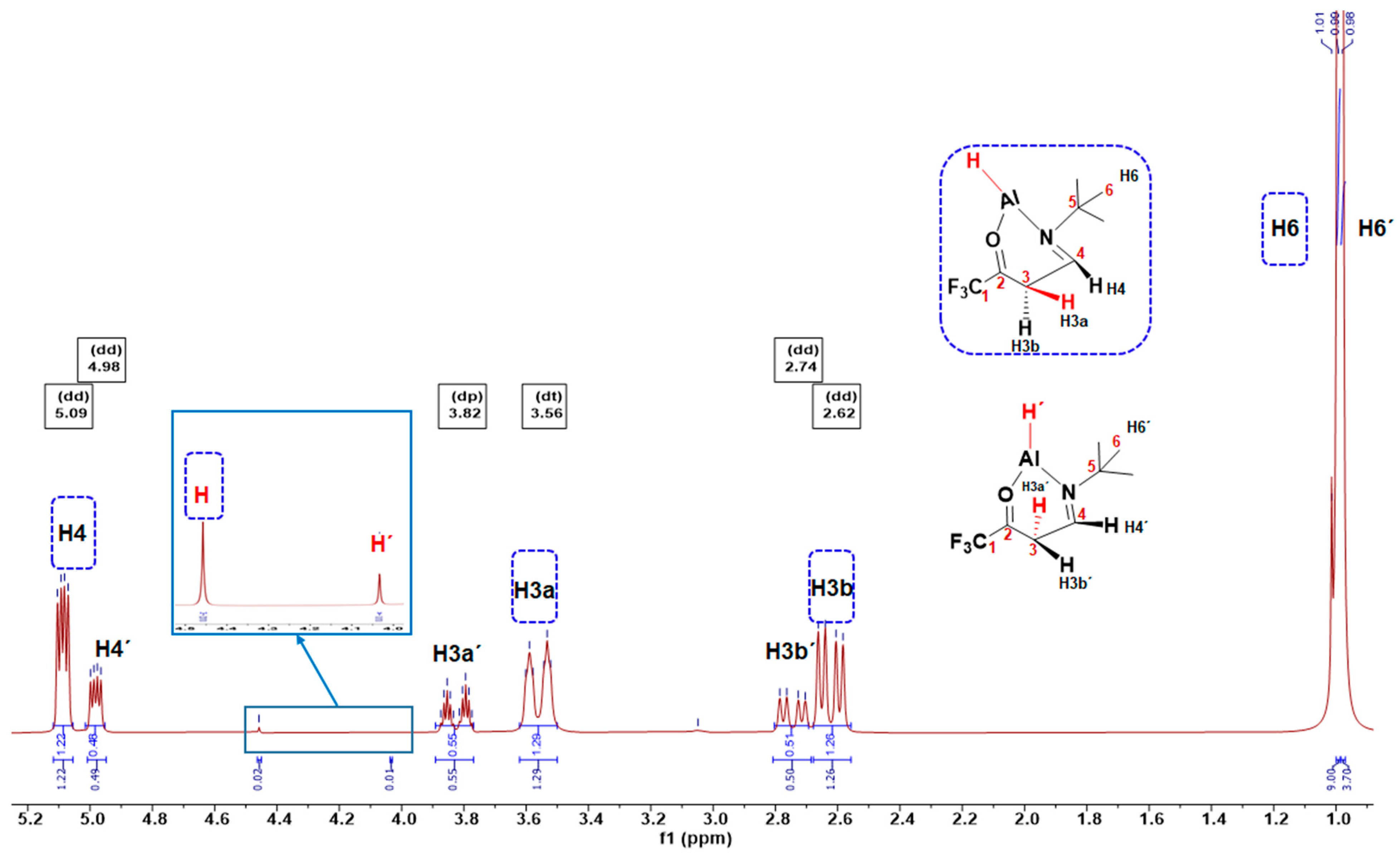
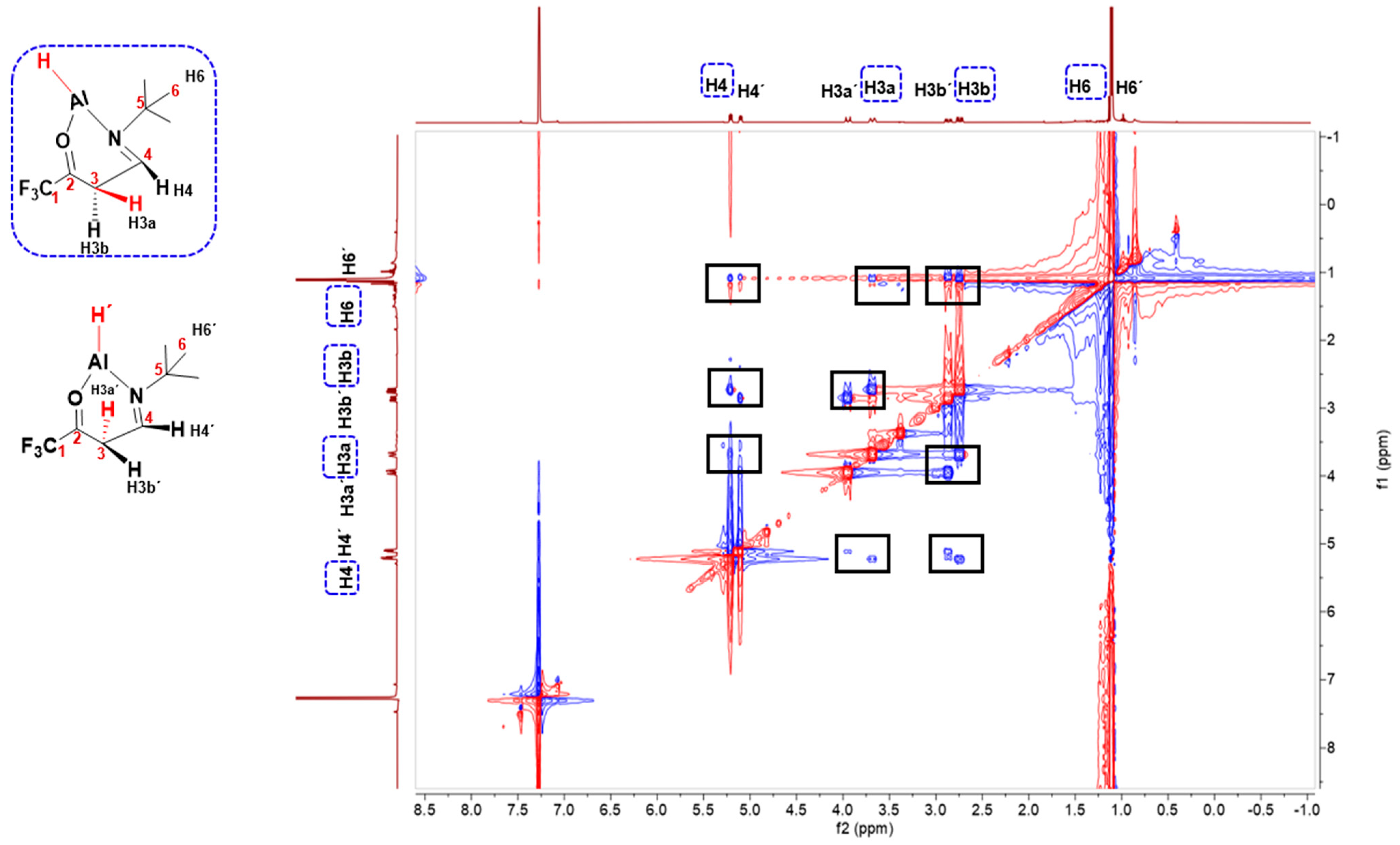
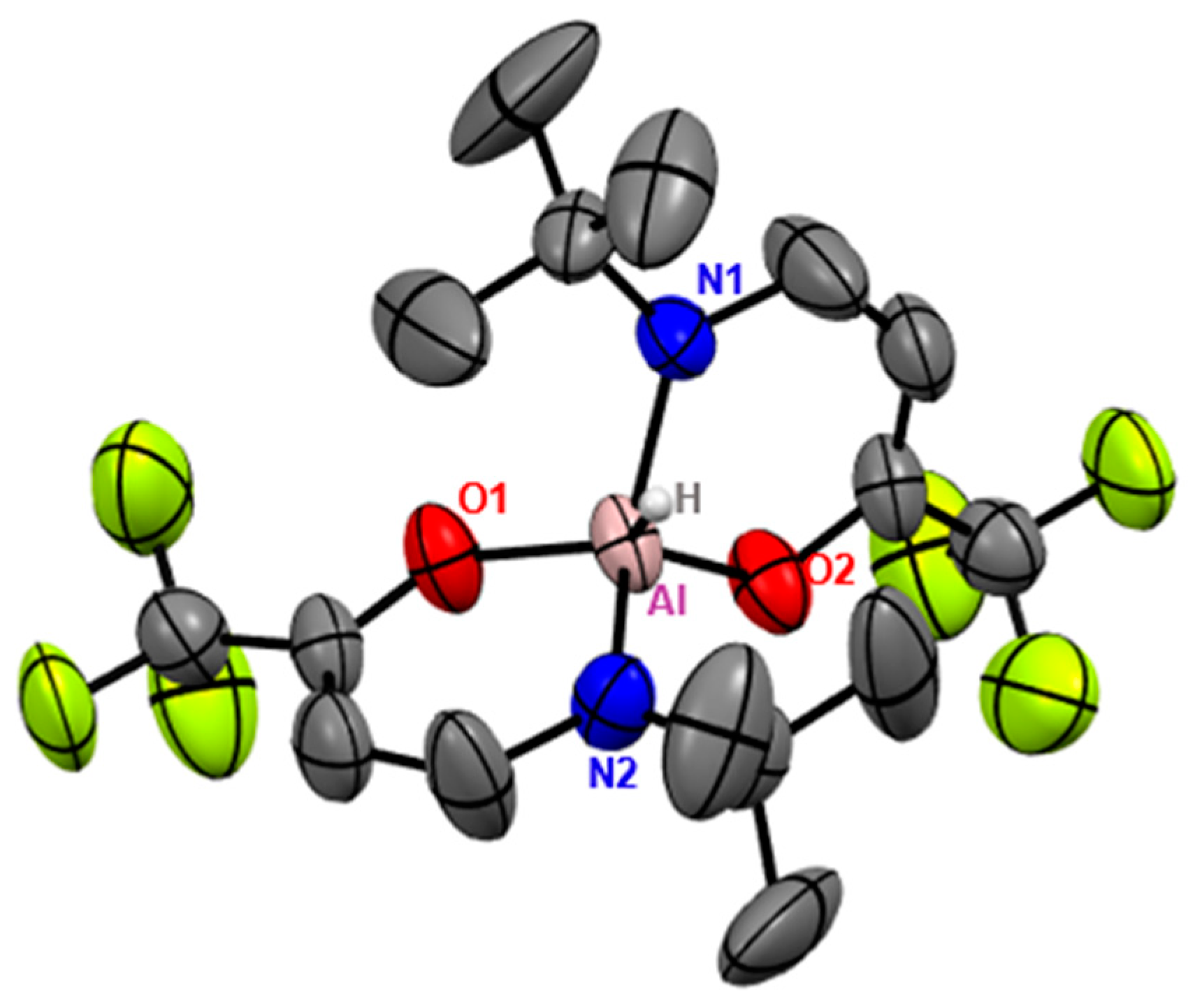

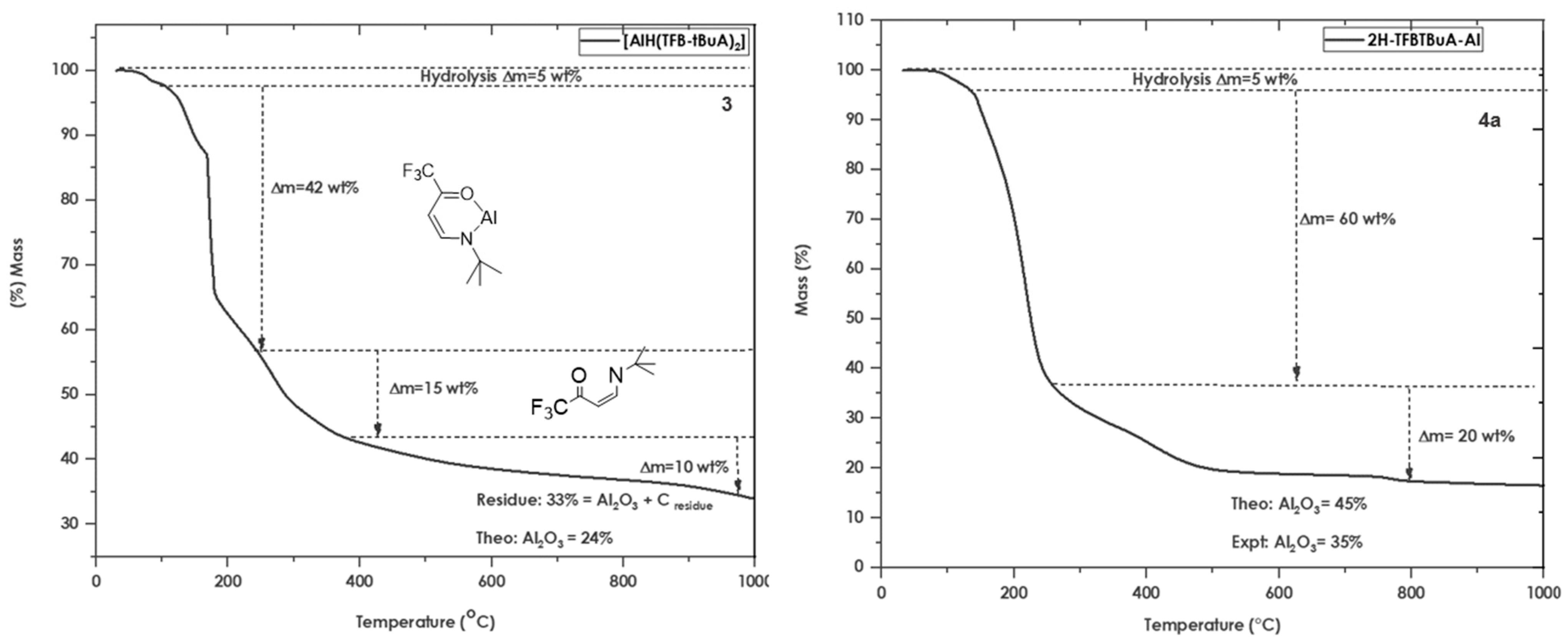
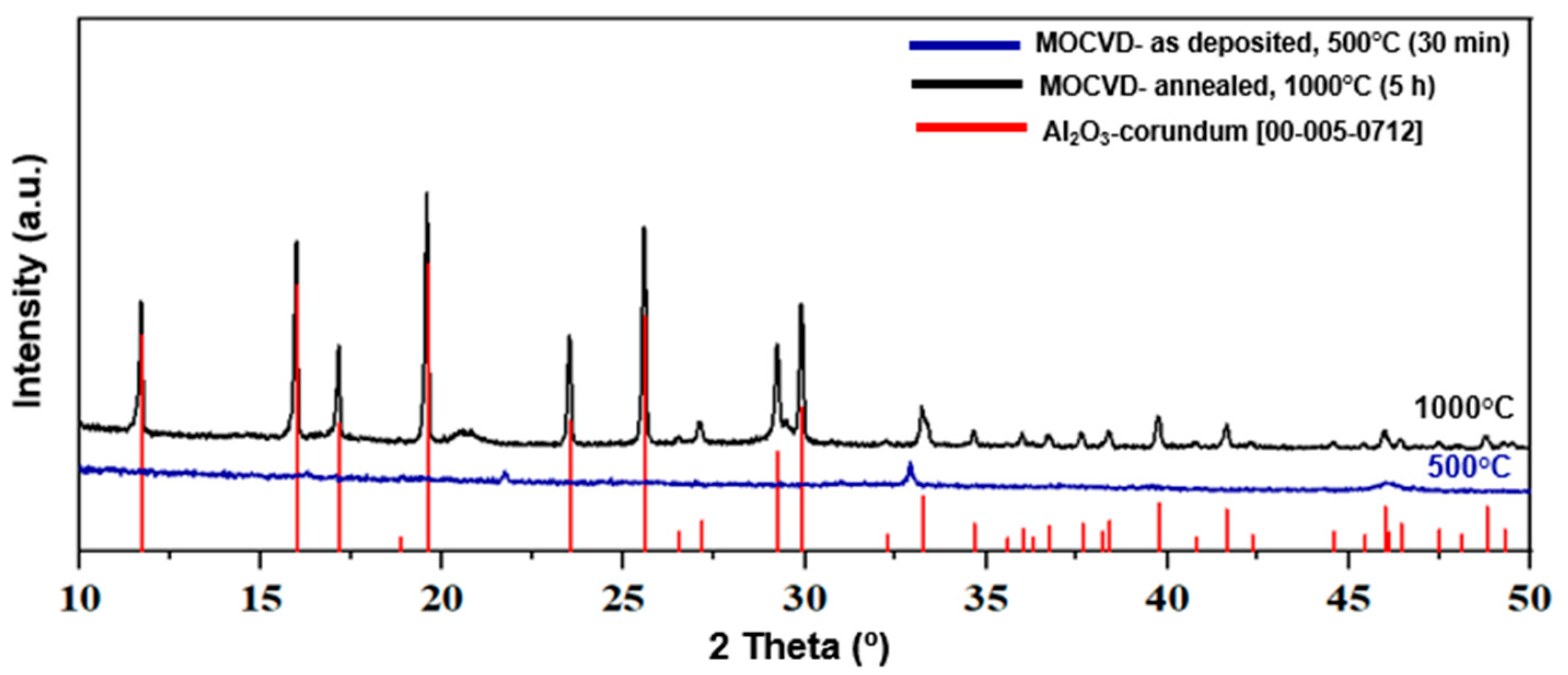
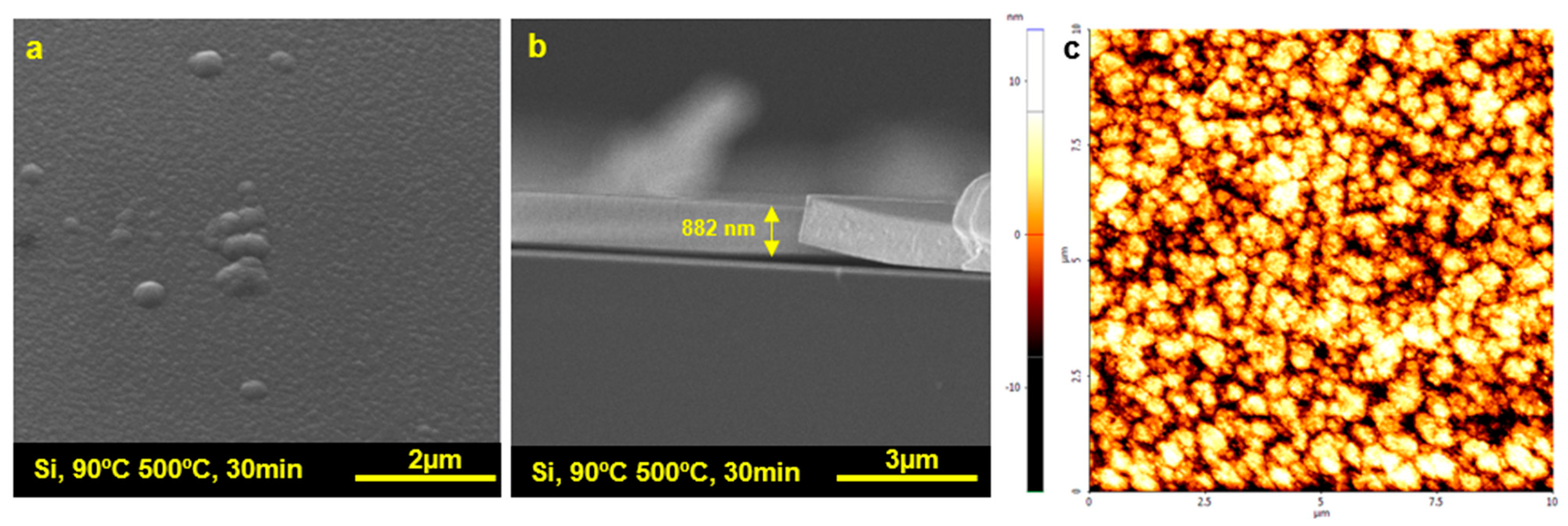
| Compound | [HAl(TFB-TBA)-H]2 4a |
|---|---|
| formula | C16H26Al2F6N2O2 |
| M [g mol−1] | 446.35 |
| Crystal system | monoclinic |
| Space group | P21/n |
| T [K] | 102.00 |
| a [Å] | 8.3199(5) |
| B [Å] | 11.9294(8) |
| C [Å] | 10.1986(5) |
| A [°] | 90 |
| Β [°] | 90.764(2) |
| γ [°] | 90 |
| V [Å3] | 1012.14(10) |
| Z | 2 |
| No. of unique rfIns, Rint | 4467, 0.0913 |
| Goodness of fit | 1.095 |
| Final R indices [I >= 2σ (I)]: R1, wR2 | 0.0405, 0.0914 |
| R indices [all data]: R1, wR2 | 0.0522, 0.0962 |
| Largest diff. peak and hole | 0.72, −0.39 |
| Bond Lengths & Angles | [H2Al(TFB-TBA)]2 4a |
|---|---|
| Al1-O1 | 1.7520(11) |
| Al1-H1 | 1.482(2) |
| Al2-O2 | 1.7520(11) |
| Al1-N1 | 1.9548(11) |
| Al1-N2 | 1.9574(11) |
| Al2-N1 | 1.9574(11) |
| Al2-N2 | 1.9548(11) |
| Al1-Al2 | 2.7674(8) |
| N1-C4 | 1.520(1) |
| C3-C4 | 1.507(1) |
| C3-C2 | 1.330(1) |
| C4-H4 | 0.990 |
| C3-H3 | 0.9500 |
| N1-Al1-N2 | 89.94(3) |
| N2-Al1-O1 | 114.42(4) |
| O1-Al1-H1 | 112.4(6) |
| N1-Al1-O1 | 104.22(4) |
Disclaimer/Publisher’s Note: The statements, opinions and data contained in all publications are solely those of the individual author(s) and contributor(s) and not of MDPI and/or the editor(s). MDPI and/or the editor(s) disclaim responsibility for any injury to people or property resulting from any ideas, methods, instructions or products referred to in the content. |
© 2023 by the authors. Licensee MDPI, Basel, Switzerland. This article is an open access article distributed under the terms and conditions of the Creative Commons Attribution (CC BY) license (https://creativecommons.org/licenses/by/4.0/).
Share and Cite
Amadi, C.K.; Atamtürk, U.; Lichtenberg, A.; Raauf, A.; Mathur, S. Undirected C-H Bond Activation in Aluminium Hydrido Enaminonates. Molecules 2023, 28, 2137. https://doi.org/10.3390/molecules28052137
Amadi CK, Atamtürk U, Lichtenberg A, Raauf A, Mathur S. Undirected C-H Bond Activation in Aluminium Hydrido Enaminonates. Molecules. 2023; 28(5):2137. https://doi.org/10.3390/molecules28052137
Chicago/Turabian StyleAmadi, Chijioke Kingsley, Ufuk Atamtürk, Andreas Lichtenberg, Aida Raauf, and Sanjay Mathur. 2023. "Undirected C-H Bond Activation in Aluminium Hydrido Enaminonates" Molecules 28, no. 5: 2137. https://doi.org/10.3390/molecules28052137
APA StyleAmadi, C. K., Atamtürk, U., Lichtenberg, A., Raauf, A., & Mathur, S. (2023). Undirected C-H Bond Activation in Aluminium Hydrido Enaminonates. Molecules, 28(5), 2137. https://doi.org/10.3390/molecules28052137






